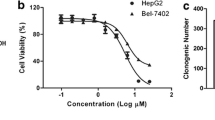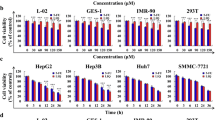Abstract
6-methoxydihydrosanguinarine (6-MS), a natural benzophenanthridine alkaloid extracted from Macleaya cordata (Willd.) R. Br, has shown to trigger apoptotic cell death in cancer cells. However, the exact mechanisms involved have not yet been clarified. The current study reveals the underlying mechanisms of 6-MS-induced cytotoxicity in hepatocellular carcinoma (HCC) cells and investigates whether 6-MS sensitizes TNF-related apoptosis inducing ligand (TRAIL)-induced apoptosis. 6-MS was shown to suppress cell proliferation and trigger cell cycle arrest, DNA damage, and apoptosis in HCC cells. Mechanisms analysis indicated that 6-MS promoted reactive oxygen species (ROS) generation, JNK activation, and inhibits EGFR/Akt signaling pathway. DNA damage and apoptosis induced by 6-MS were reversed following N-acetyl-l-cysteine (NAC) treatment. The enhancement of PARP cleavage caused by 6-MS was abrogated by pretreatment with JNK inhibitor SP600125. Furthermore, 6-MS enhanced TRAIL-mediated HCC cells apoptosis by upregulating the cell surface receptor DR5 expression. Pretreatment with NAC attenuated 6-MS-upregulated DR5 protein expression and alleviated cotreatment-induced viability reduction, cleavage of caspase-8, caspase-9, and PARP. Overall, our results suggest that 6-MS exerts cytotoxicity by modulating ROS generation, EGFR/Akt signaling, and JNK activation in HCC cells. 6-MS potentiates TRAIL-induced apoptosis through upregulation of DR5 via ROS generation. The combination of 6-MS with TRAIL may be a promising strategy and warrants further investigation.













Similar content being viewed by others
Data availability
Data can be available upon request from the corresponding author.
Reference
Xia C, Dong X, Li H, Cao M, Sun D, He S, et al. Cancer statistics in China and United States, 2022: profiles, trends, and determinants. Chin Med J (Engl). 2022;135(5):584–90.
Yarchoan M, Agarwal P, Villanueva A, Rao S, Dawson LA, Llovet JM, et al. Recent developments and therapeutic strategies against hepatocellular carcinoma. Cancer Res. 2019;79(17):4326–30.
Meyers BM, Knox JJ, Cosby R, Beecroft JR, Chan KK, Coburn N, et al. Non-surgical management of advanced hepatocellular carcinoma: a systematic review by cancer care ontario. Can Liver J. 2021;4(3):257–74.
Hymowitz SG, Christinger HW, Fuh G, Ultsch M, O’Connell M, Kelley RF, et al. Triggering cell death: the crystal structure of Apo2L/TRAIL in a complex with death receptor 5. Mol Cell. 1999;4(4):563–71.
Snajdauf M, Havlova K, Vachtenheim J Jr, Ozaniak A, Lischke R, Bartunkova J, et al. The TRAIL in the treatment of human cancer: an update on clinical trials. Front Mol Biosci. 2021;8: 628332.
Kusaba M, Nakao K, Goto T, Nishimura D, Kawashimo H, Shibata H, et al. Abrogation of constitutive STAT3 activity sensitizes human hepatoma cells to TRAIL-mediated apoptosis. J Hepatol. 2007;47(4):546–55.
Kurita S, Higuchi H, Saito Y, Nakamoto N, Takaishi H, Tada S, et al. DNMT1 and DNMT3b silencing sensitizes human hepatoma cells to TRAIL-mediated apoptosis via up-regulation of TRAIL-R2/DR5 and caspase-8. Cancer Sci. 2010;101(6):1431–9.
Chaudhry GE, Md Akim A, Sung YY, Sifzizul TMT. Cancer and apoptosis: The apoptotic activity of plant and marine natural products and their potential as targeted cancer therapeutics. Front Pharmacol. 2022;13: 842376.
Nisar S, Masoodi T, Prabhu KS, Kuttikrishnan S, Zarif L, Khatoon S, et al. Natural products as chemo-radiation therapy sensitizers in cancers. Biomed Pharmacother. 2022;154: 113610.
Zhao S, Tang Y, Wang R, Najafi M. Mechanisms of cancer cell death induction by paclitaxel: an updated review. Apoptosis. 2022;27(9–10):647–67.
Ruan Q, Patel G, Wang J, Luo E, Zhou W, Sieniawska E, et al. Current advances of endophytes as a platform for production of anti-cancer drug camptothecin. Food Chem Toxicol. 2021;151: 112113.
Zhang D, Kanakkanthara A. Beyond the paclitaxel and vinca alkaloids: next generation of plant-derived microtubule-targeting agents with potential anticancer activity. Cancers (Basel). 2020;12(7):1721.
Ullah A, Ullah N, Nawaz T, Aziz T. Molecular mechanisms of sanguinarine in cancer prevention and treatment. Anticancer Agents Med Chem. 2023;23(7):765–78.
Liu F, Wang H, Zhu X, Jiang N, Pan F, Song C, et al. Sanguinarine promotes healthspan and innate immunity through a conserved mechanism of ROS-mediated PMK-1/SKN-1 activation. iScience. 2022;25(3):103874.
Lee YJ, Yin HQ, Kim YH, Li GY, Lee BH. Apoptosis inducing effects of 6-methoxydihydrosanguinarine in HT29 colon carcinoma cells. Arch Pharm Res. 2004;27(12):1253–7.
Zhang L, Zhang X, Che D, Zeng L, Zhang Y, Nan K, et al. 6-Methoxydihydrosanguinarine induces apoptosis and autophagy in breast cancer MCF-7 cells by accumulating ROS to suppress the PI3K/AKT/mTOR signaling pathway. Phytother Res. 2023;37(1):124–39.
Yin HQ, Kim YH, Moon CK, Lee BH. Reactive oxygen species-mediated induction of apoptosis by a plant alkaloid 6-methoxydihydrosanguinarine in HepG2 cells. Biochem Pharmacol. 2005;70(2):242–8.
Hühn D, Bolck HA, Sartori AA. Targeting DNA double-strand break signalling and repair: recent advances in cancer therapy. Swiss Med Wkly. 2013;143:w13837.
Zhang P, Chen L, Zhou F, He Z, Wang G, Luo Y. NRP1 promotes prostate cancer progression via modulating EGFR-dependent AKT pathway activation. Cell Death Dis. 2023;14(2):159.
Li R, Zheng C, Shiu PH, Rangsinth P, Wang W, Kwan YW, et al. Garcinone E triggers apoptosis and cell cycle arrest in human colorectal cancer cells by mediating a reactive oxygen species-dependent JNK signaling pathway. Biomed Pharmacother. 2023;162: 114617.
Jekimovs C, Bolderson E, Suraweera A, Adams M, O’Byrne KJ, Richard DJ. Chemotherapeutic compounds targeting the DNA double-strand break repair pathways: the good, the bad, and the promising. Front Oncol. 2014;4:86.
Prendergast ÁM, Cruet-Hennequart S, Shaw G, Barry FP, Carty MP. Activation of DNA damage response pathways in human mesenchymal stem cells exposed to cisplatin or γ-irradiation. Cell Cycle. 2011;10(21):3768–77.
Morii M, Fukumoto Y, Kubota S, Yamaguchi N, Nakayama Y, Yamaguchi N. Imatinib inhibits inactivation of the ATM/ATR signaling pathway and recovery from adriamycin/doxorubicin-induced DNA damage checkpoint arrest. Cell Biol Int. 2015;39(8):923–32.
Michalkova R, Kello M, Kudlickova Z, Gazdova M, Mirossay L, Mojzisova G, et al. Programmed cell death alterations mediated by synthetic indole chalcone resulted in cell cycle arrest, dna damage, apoptosis and signaling pathway modulations in breast cancer model. Pharmaceutics. 2022;14(3):503.
Jan R, Chaudhry GE. Understanding apoptosis and apoptotic pathways targeted cancer therapeutics. Adv Pharm Bull. 2019;9(2):205–18. https://doi.org/10.15171/apb.2019.024.
Kucukler S, Darendelioğlu E, Caglayan C, Ayna A, Yıldırım S, Kandemir FM. Zingerone attenuates vancomycin-induced hepatotoxicity in rats through regulation of oxidative stress, inflammation and apoptosis. Life Sci. 2020;259: 118382.
Caglayan C, Kandemir FM, Ayna A, Gür C, Küçükler S, Darendelioğlu E. Neuroprotective effects of 18β-glycyrrhetinic acid against bisphenol a-induced neurotoxicity in rats: involvement of neuronal apoptosis, endoplasmic reticulum stress and JAK1/STAT1 signaling pathway. Metab Brain Dis. 2022;37(6):1931–40.
Kwon S, Ko H, You DG, Kataoka K, Park JH. Nanomedicines for reactive oxygen species mediated approach: an emerging paradigm for cancer treatment. Acc Chem Res. 2019;52(7):1771–82.
Emre Kızıl H, Gür C, Ayna A, Darendelioğlu E, Küçükler S, Sağ S. Contribution of oxidative stress, apoptosis, endoplasmic reticulum stress and autophagy pathways to the ameliorative effects of hesperidin in naf-induced testicular toxicity. Chem Biodivers. 2023;20(3): e202200982.
Pizzino G, Irrera N, Cucinotta M, Pallio G, Mannino F, Arcoraci V, et al. Oxidative stress: harms and benefits for human health. Oxid Med Cell Longev. 2017;2017:8416763.
Wu J, Wang D, Zhou J, Li J, Xie R, Li Y, et al. Gambogenic acid induces apoptosis and autophagy through ROS-mediated endoplasmic reticulum stress via JNK pathway in prostate cancer cells. Phytother Res. 2023;37(1):310–28.
Sies H, Belousov VV, Chandel NS, Davies MJ, Jones DP, Mann GE, et al. Defining roles of specific reactive oxygen species (ROS) in cell biology and physiology. Nat Rev Mol Cell Biol. 2022;23(7):499–515.
Hu B, Zou T, Qin W, Shen X, Su Y, Li J, et al. Inhibition of EGFR overcomes acquired lenvatinib resistance driven by STAT3-ABCB1 signaling in hepatocellular carcinoma. Cancer Res. 2022;82(20):3845–57.
Su ZJ, Liu XY, Zhang JH, Ke SY, Fei HJ. Neurotensin promotes cholangiocarcinoma metastasis via the EGFR/AKT pathway. Gene. 2019;687:143–50.
Yan X, Yang P, Liu H, Zhao Y, Wu Z, Zhang B. miR-4461 inhibits the progression of Gallbladder carcinoma via regulating EGFR/AKT signaling. Cell Cycle. 2022;21(11):1166–77.
Yue J, López JM. Understanding MAPK signaling pathways in apoptosis. Int J Mol Sci. 2020;21(7):2346.
Park HB, Baek KH. E3 ligases and deubiquitinating enzymes regulating the MAPK signaling pathway in cancers. Biochim Biophys Acta Rev Cancer. 2022;1877(3): 188736.
Sun B, Liu Y, He D, Li J, Wang J, Wen W, et al. Traditional Chinese medicines and their active ingredients sensitize cancer cells to TRAIL-induced apoptosis. J Zhejiang Univ Sci B. 2021;22(3):190–203.
Zhang YY, Feng PP, Wang HF, Zhang H, Liang T, Hao XS, et al. Licochalcone B induces DNA damage, cell cycle arrest, apoptosis, and enhances TRAIL sensitivity in hepatocellular carcinoma cells. Chem Biol Interact. 2022;365: 110076.
Zhou X, Lv L, Tan Y, Zhang Z, Wei S, Xiao S. Tanshinone IIA sensitizes TRAIL-induced apoptosis in glioblastoma through inducing the expression of death receptors (and suppressing STAT3 activation). Brain Res. 2021;1766: 147515.
Acknowledgements
We thank all the contributors of the public databases used in this study
Funding
This work was supported by the Shandong Provincial Natural Science Foundation, China (No ZR2022MH178); Project of Administration of Traditional Chinese Medicine of Shandong Province, China (No 2020M064); Science and Technology Innovation Project of Taian (No 2022NS353). Natural Science Foundation of Shandong Province, ZR2022MH178, Feng-ze Wang ,Science and Technology Innovation Project of Taian, 2022NS353, lu cao , Project of Administration of Traditional Chinese Medicine of Shandong Province, 2020M064, Gang-ping Hao
Author information
Authors and Affiliations
Contributions
LW and RL: Conceptualization, draft preparation, investigation. ZZ and YS: data curation and investigation. YZ and TZ: investigation. FW: validation. GH: Funding acquisition and writing—editing. LC: Funding acquisition, writing—reviewing and editing. All authors agree to be accountable for all aspects of work ensuring integrity and accuracy.
Corresponding authors
Ethics declarations
Conflict of interest
The authors declare no conflict of interest.
Additional information
Publisher's Note
Springer Nature remains neutral with regard to jurisdictional claims in published maps and institutional affiliations.
Rights and permissions
Springer Nature or its licensor (e.g. a society or other partner) holds exclusive rights to this article under a publishing agreement with the author(s) or other rightsholder(s); author self-archiving of the accepted manuscript version of this article is solely governed by the terms of such publishing agreement and applicable law.
About this article
Cite this article
Wang, Ll., Li, Rt., Zang, Zh. et al. 6-Methoxydihydrosanguinarine exhibits cytotoxicity and sensitizes TRAIL-induced apoptosis of hepatocellular carcinoma cells through ROS-mediated upregulation of DR5. Med Oncol 40, 266 (2023). https://doi.org/10.1007/s12032-023-02129-z
Received:
Accepted:
Published:
DOI: https://doi.org/10.1007/s12032-023-02129-z




